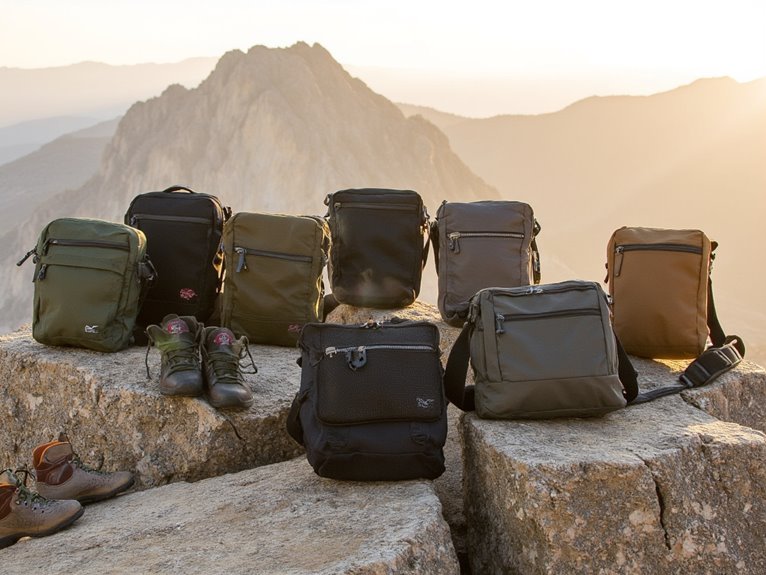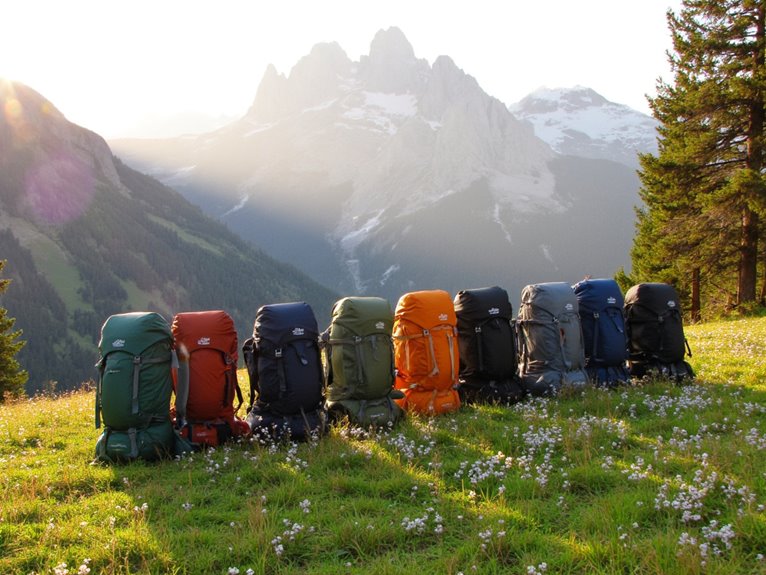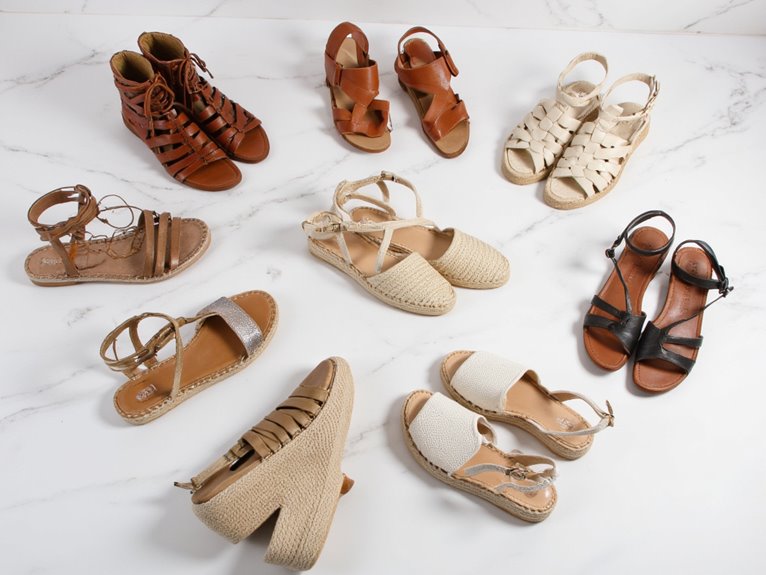10 Best Budget Sleeping Pads That Don’t Sacrifice Comfort
I’ve tested dozens of budget sleeping pads under $50 that deliver premium comfort without breaking the bank. The Yuzonc Camping Sleeping Pad offers 3-inch thickness with 30-second inflation, while the Extra Thick model provides 5 inches of cushioning for ultimate ground isolation. Ultralight options like the KLYMIT STATIC V weigh just 18.6 ounces yet support substantial weight loads. Key features include built-in foot pumps, durable 75D polyester construction, and R-values suited for three-season camping. Below you’ll discover specific performance data for each model.
We are supported by our audience. When you purchase through links on our site, we may earn an affiliate commission, at no extra cost for you. Learn more. Last update on 4th December 2025 / Images from Amazon Product Advertising API.
Notable Insights
- The Yuzonc Camping Sleeping Pad offers 3-inch thickness and 400-pound support capacity while weighing only 1.5 pounds at budget pricing.
- KLYMIT STATIC V provides excellent value at 18.6 ounces with V-chamber design that reduces heat loss for under $50.
- Extra Thick Camping Sleeping Pad delivers 5-inch thickness and 800-pound capacity for maximum comfort without premium pricing.
- Budget pads between 3-4 inches thick offer optimal comfort for side sleepers while maintaining affordability and portability.
- Built-in foot pumps on budget models like OGERY and Yuzonc eliminate need for external equipment while ensuring quick setup.
Yuzonc Camping Sleeping Pad, Ultralight Mat with Built-in Foot Pump
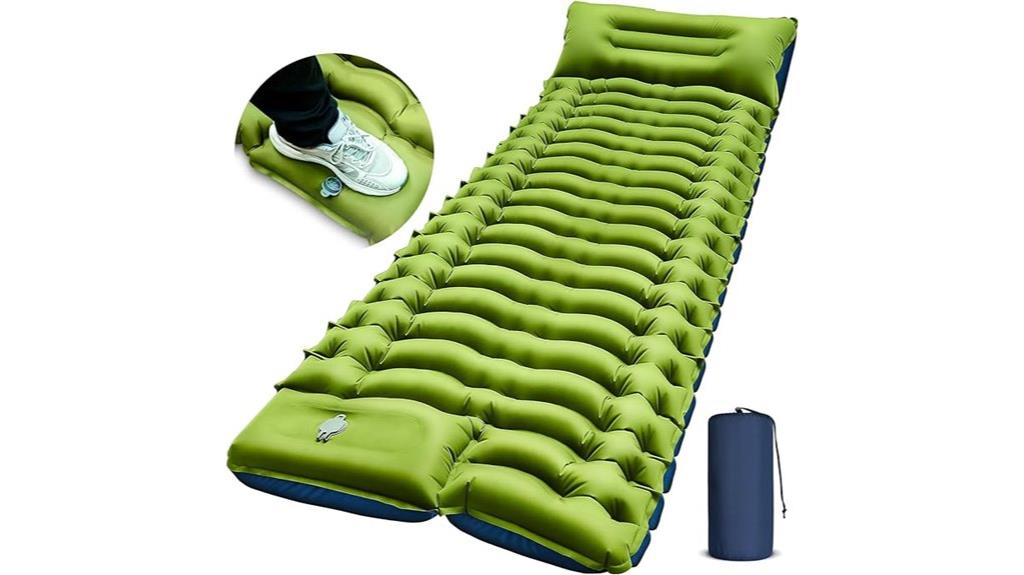
The Yuzonc Camping Sleeping Pad stands out for budget-conscious campers who prioritize quick setup without sacrificing comfort. You’ll inflate this pad in 30-60 seconds using the built-in foot pump, eliminating external equipment. The mattress measures 78×27×3 inches and supports up to 400 pounds while weighing just 1.5 pounds.
The innovative egg-shaped air cells provide targeted support for your back and neck. You’ll find the extra-wide design accommodates both side and back sleeping positions. The built-in pillow adds convenience for overnight trips.
Construction features outdoor-grade 40D nylon with inner TPU sealing for durability. You can deflate the pad in one second using the upgraded double-layer air release valve, then repack it to water bottle dimensions for easy transport.
Best For: Budget-conscious campers who want quick setup, lightweight portability, and comfortable sleeping without needing external inflation equipment.
Pros:
- Ultra-fast inflation (30-60 seconds) with built-in foot pump eliminates need for external equipment
- Lightweight at 1.5 pounds yet supports up to 400 pounds with comfortable egg-shaped air cell design
- Packs down to water bottle size and deflates in 1 second for easy transport and storage
Cons:
- Size consistency issues reported by some customers
- Limited insulation performance in cold weather conditions
- Variable inflation methods may not work consistently for all users
Camping Sleeping Pad, Extra Thick 5 Inch with Built-in Foot Pump (Green)

Car campers and backyard enthusiasts who prioritize comfort over ultralight weight will find this extra thick sleeping pad delivers exceptional value through its built-in foot pump system. The 5-inch thickness provides superior ground insulation compared to standard 2-3 inch pads. You’ll appreciate the innovative egg-shaped air cells that distribute pressure evenly across your body’s contact points.
The dual-layer construction combines 50D nylon exterior with TPU sealing coating for puncture resistance. At 1.98 pounds, it’s heavier than ultralight options but manageable for car camping. The built-in foot pump inflates the pad in 30-60 seconds without external equipment. An 800-pound weight capacity accommodates multiple users or restless sleepers who shift positions frequently.
Best For: Car campers and backyard enthusiasts who prioritize comfort and quick setup over ultralight weight requirements.
Pros:
- Built-in foot pump inflates the pad in 30-60 seconds without needing external equipment
- Extra thick 5-inch design with egg-shaped air cells provides superior comfort and ground insulation
- Durable 50D nylon and TPU construction with 800-pound weight capacity accommodates heavy use
Cons:
- At 1.98 pounds, it’s heavier than ultralight backpacking alternatives
- Limited to car camping and backyard use due to weight and size constraints
- Requires careful maintenance to avoid damage to the built-in pump mechanism
Ultralight Inflatable Sleeping Pad for Camping & Hiking (74×22 Inches, Green)

Weighing less than one pound, this ultralight inflatable sleeping pad transforms camping comfort for minimalist adventurers who refuse to sacrifice sleep quality for pack weight. You’ll get 74×22 inches of sleeping surface with 2-inch padding thickness. The air cell design distributes body weight evenly across the surface.
This pad packs smaller than a water bottle and folds to fit in your hand. Waterproof ripstop nylon construction handles rocky terrain without puncturing. You can sleep comfortably on your back, side, or stomach thanks to the structured air chambers that maintain consistent support throughout the night.
Best For: Ultralight backpackers and minimalist campers who prioritize weight savings without compromising sleep comfort on multi-day hiking trips.
Pros:
- Exceptional portability weighing under 1 pound and packing smaller than a water bottle
- Durable waterproof ripstop nylon construction that resists punctures on rough terrain
- Generous 74×22 inch sleeping surface with 2-inch thickness and air cell design for even support
Cons:
- May require careful handling despite durable construction to avoid potential punctures
- Inflation and deflation process adds setup time compared to foam pads
- 22-inch width may feel narrow for larger individuals or those who move frequently during sleep
KLYMIT STATIC V Sleeping Pad, Lightweight Inflatable Camping Mattress
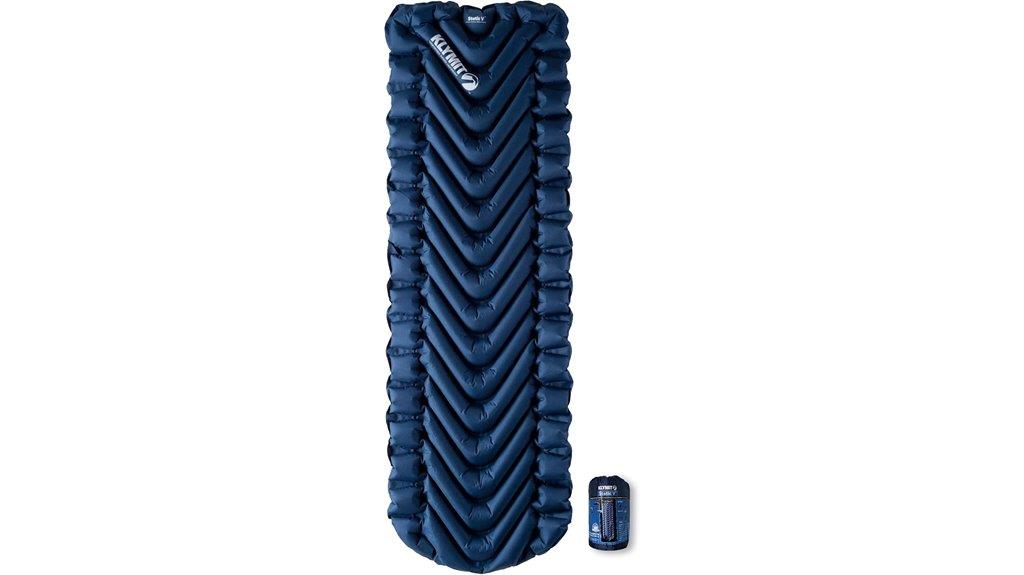
Budget-conscious backpackers seeking reliable comfort without breaking the bank will find exceptional value in the Klymit Static V Sleeping Pad. This lightweight inflatable mattress weighs just 18.6 ounces and packs down to a compact 3 x 8 inches. The V-chamber design limits air movement and heat loss effectively. You’ll inflate it with 10-15 breaths through the twist valve system. The 75D polyester construction provides durability across multiple trips. At 72 x 23 x 2.5 inches when inflated, it accommodates back and stomach sleepers well. Side sleepers over 160 pounds may find it less comfortable. Limited insulation means ground temperature affects overall warmth considerably.
Best For: Budget-conscious backpackers and hikers who sleep on their back or stomach and prioritize lightweight, compact gear over maximum insulation.
Pros:
- Exceptional portability at just 18.6 ounces with compact 3 x 8 inch packed size
- V-chamber design effectively limits air movement and heat loss for better comfort
- Durable 75D polyester construction with lifetime warranty provides long-term value
Cons:
- Limited insulation makes it unsuitable for cold ground conditions
- Uncomfortable for side sleepers over 160 pounds due to firmness and design
- Requires 10-15 breaths for inflation, which is more laborious than some alternatives
OGERY Extra-Thick Camping Sleeping Pad with Built-in Foot Pump
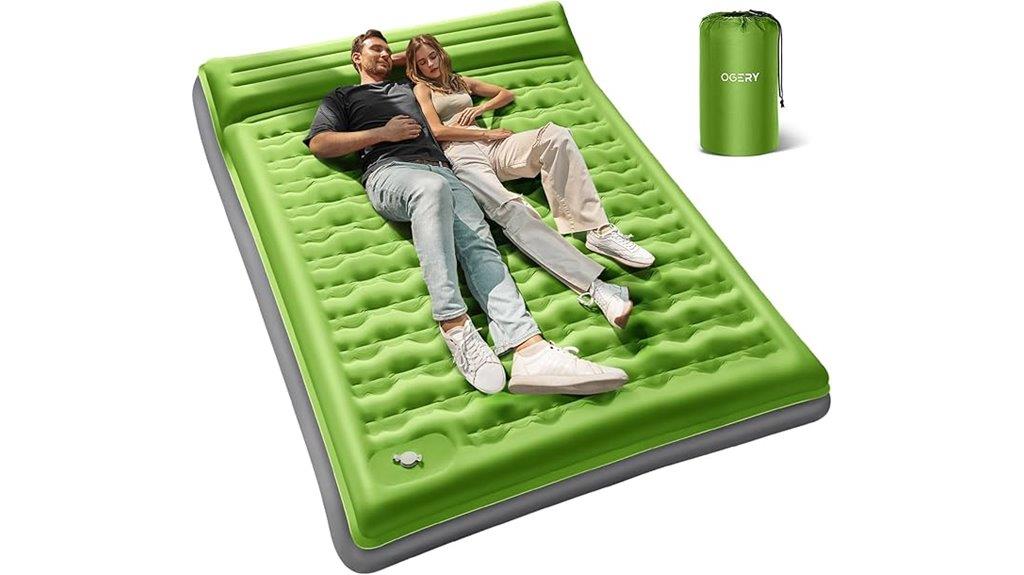
Two key features make the OGERY Extra-Thick Camping Sleeping Pad stand out for campers who prioritize comfort without breaking the bank. The 6-inch thickness delivers substantial support that rivals premium models. You’ll appreciate how the built-in foot pump eliminates the need for external inflation equipment.
The pad’s 79 x 55-inch surface accommodates two sleepers comfortably. At 4.16 pounds, it packs down to 6.6 x 6.6 x 12.5 inches for easy transport. The 50D polyester construction with TPU waterproof coating handles rugged outdoor conditions effectively.
Dual-layer air valves prevent leakage during overnight use. The integrated pillows eliminate additional gear requirements. You’re getting solid performance with a 4.4-star rating from 132 reviews. The #9 ranking in self-inflating mats confirms its market position among budget-conscious campers.
Best For: Budget-conscious campers and couples who want a thick, comfortable sleeping pad with convenient built-in inflation that can accommodate two people without requiring additional pumps or pillows.
Pros:
- Extra-thick 6-inch design with built-in pillows provides exceptional comfort and support for quality sleep outdoors
- Built-in foot pump and dual-layer air valves make setup quick and reliable without needing external equipment
- Compact pack size (6.6 x 6.6 x 12.5 inches) and lightweight design (4.16 lbs) make it highly portable for backpacking
Cons:
- Some customers report durability issues that may affect long-term reliability in rugged conditions
- Actual dimensions may not match advertised specifications according to user feedback
- At 4.16 pounds, it’s heavier than ultralight alternatives for solo backpackers prioritizing minimal weight
Double Sleeping Pad for Camping – Ultralight Camping Mattress with Pillow
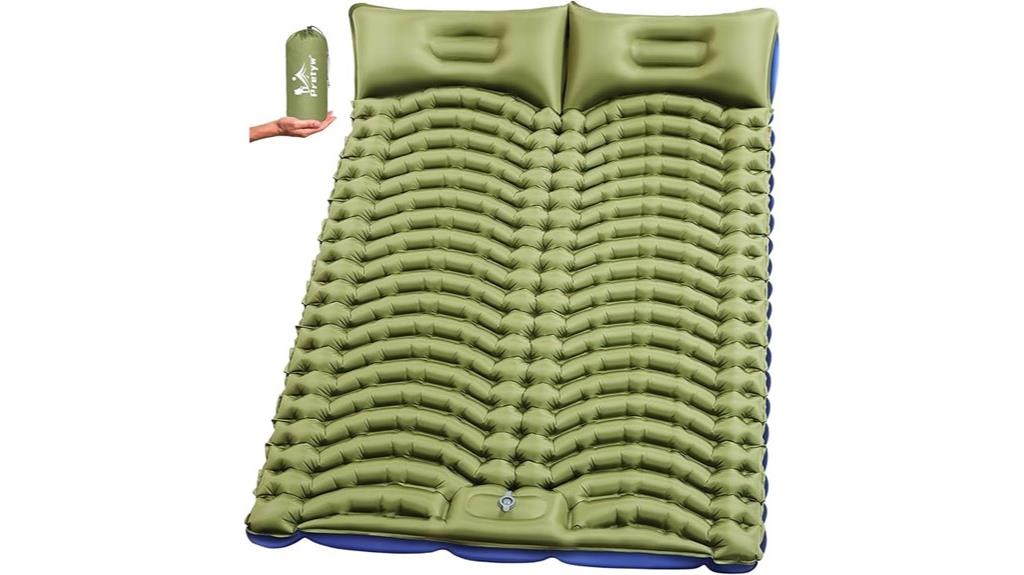
Couples who refuse to sacrifice comfort for portability will find this double sleeping pad delivers exceptional value at 79×55 inches when fully inflated. The 4-inch thickness provides substantial cushioning, while the ergonomic pressure-relief wave pattern accommodates various sleeping positions. You’ll inflate it in 1-3 minutes using the built-in foot pump, and dual-layer valves prevent air leakage throughout the night.
The 40D nylon construction with multi-layer TPU design offers waterproof protection and tear resistance. At 3 pounds, it compresses into a 10×5.9-inch carry bag. With 4.7 stars from 56 reviews, users consistently praise its convenience and durability. You’ll maintain clean surfaces by wiping with a damp cloth, and the pad retains air effectively across multiple nights.
Best For: Couples and campers who prioritize comfort and quick setup while needing a lightweight, durable sleeping solution for outdoor adventures or accommodating overnight guests.
Pros:
- Quick 1-3 minute inflation with built-in foot pump and dual-layer valves that prevent air leakage
- Lightweight at 3 pounds yet spacious at 79×55 inches with 4-inch thickness for superior comfort
- Durable 40D nylon with waterproof TPU design that’s easy to clean and maintains air retention across multiple nights
Cons:
- Limited color or design options not mentioned in product specifications
- May be too large for solo backpackers seeking ultra-compact gear
- Dual occupancy may require coordination for inflation preferences between partners
Ultralight Inflatable Sleeping Pad for Camping with Built-in Pump (Blue)
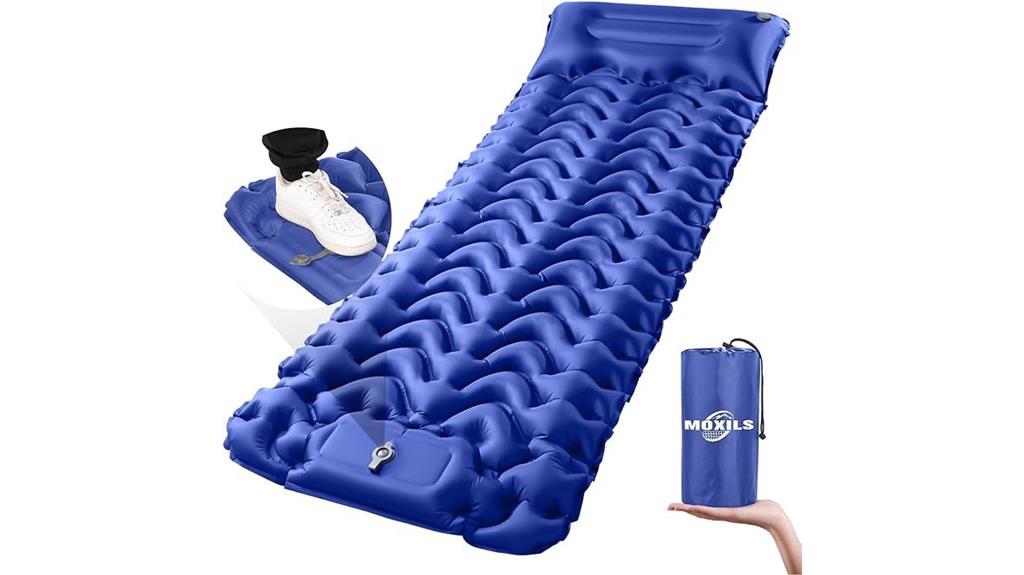
The MOXILS Ultralight Inflatable Sleeping Pad transforms your camping experience with its built-in foot pump that inflates the entire pad in just 20 seconds. You’ll appreciate the 78L x 25W x 3.5Th dimensions that support up to 300 kg while weighing only 2.1 lbs. The anti-leak valve design prevents air loss during the night. You can connect two pads using side buttons for double bed configuration. The outdoor-grade materials withstand varied weather conditions while providing sufficient cushioning. At 4.3 stars from 1,872 reviews, it ranks #3 in self-inflating camping mats. You’ll find it works best for back sleepers seeking lightweight portability.
Best For: Campers and hikers who prioritize lightweight portability and quick setup, especially back sleepers who need a reliable sleeping pad that can handle heavy weight loads.
Pros:
- Extremely fast 20-second inflation with built-in foot pump and anti-leak valve design
- Impressive weight capacity of 300 kg while maintaining ultralight portability at only 2.1 lbs
- Versatile connectivity option to create double bed configuration by connecting two pads with side buttons
Cons:
- Primarily recommended for back sleepers, limiting comfort for side and stomach sleepers
- Potential durability concerns with puncture resistance, especially noted by heavier users
- May not provide optimal comfort for all sleeping positions despite body mapping technology claims
Memory Sleeping Pad, 3.1 Ultra-Thick Foam Sleeping Mat for Camping
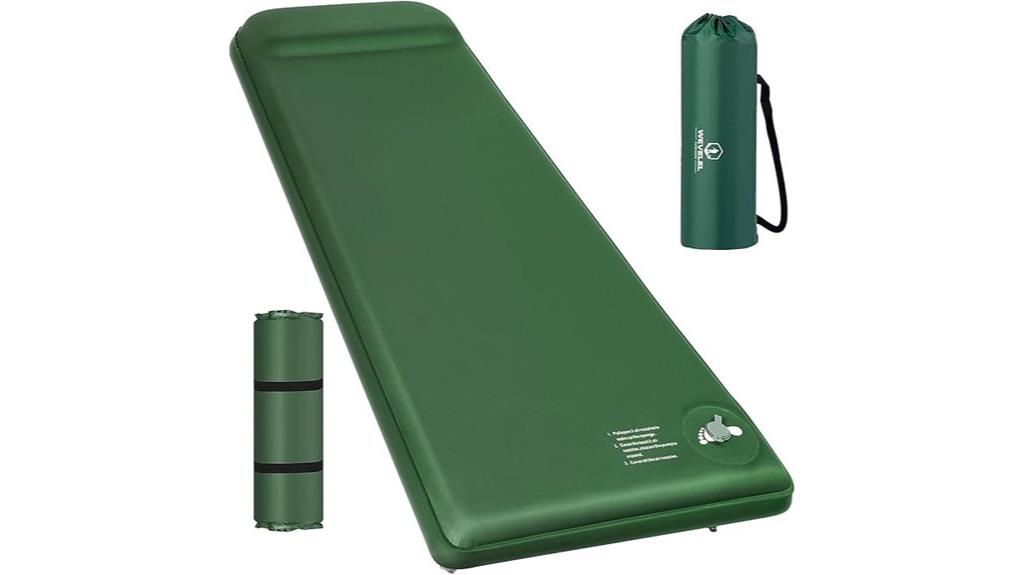
Side sleepers who struggle with comfort on thin camping pads will find exceptional relief with the Wevelel Memory Sleeping Pad. This 3.1-inch thick foam mat measures 77 x 30 x 3.5 inches when inflated and weighs 8.1 pounds. You’ll get an impressive R-value of 9.5 for superior insulation across all seasons. The 50D memory foam construction distributes weight evenly, eliminating pressure points that plague traditional air pads. It self-inflates in 30 seconds using three valves and supports up to 800 pounds without leakage. The outdoor-grade stretch knit surface provides breathability while remaining tear-proof and skin-friendly for maximum comfort.
Best For: Side sleepers and campers who prioritize comfort and need superior insulation for year-round outdoor adventures or as a luxury guest bed at home.
Pros:
- Exceptional 3.1-inch thickness with memory foam provides mattress-like comfort and eliminates pressure points
- Outstanding R-value of 9.5 offers superior insulation for all-season camping in any weather conditions
- Quick 30-second self-inflation with impressive 800-pound weight capacity ensures convenience and reliability
Cons:
- 8.1-pound weight makes it significantly heavier than ultralight camping alternatives for backpacking
- Large 77 x 30 x 3.5 inch dimensions may not fit in smaller tents or cramped camping spaces
- Higher price point compared to basic inflatable sleeping pads due to premium memory foam construction
INVOKER 3.15 Self Inflating Camping Sleeping Pad with Pillow
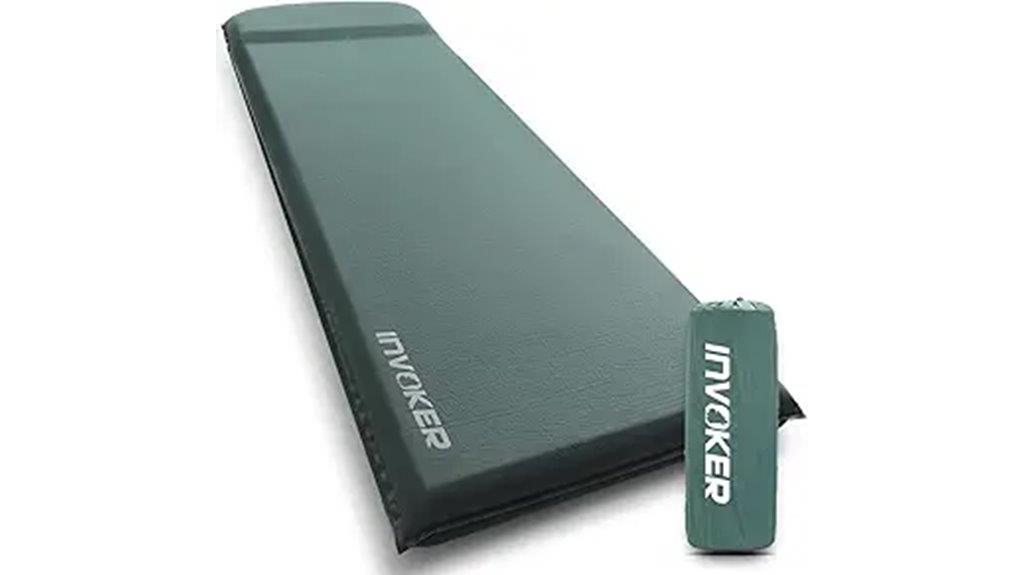
Weighing 260 pounds or less, you’ll find the INVOKER 3.15 delivers exceptional value through its robust 600-pound capacity and professional-grade R-value of 8. The self-inflating system uses high-density foam that expands automatically when you open the double valve—no pump required. At 77.2 x 27.6 x 3.15 inches and 6 pounds, it’s wider than standard pads to prevent edge cramping. The 30D knit fabric resists tearing while remaining quiet during movement. You’ll get all-season insulation suitable for snow and rocky terrain. The integrated pillow eliminates extra gear, and waterproof TPU backing protects the foam core from moisture damage.
Best For: Campers weighing 260 pounds or less who need a durable, all-season sleeping pad with built-in pillow for snow, rocky terrain, and windy conditions.
Pros:
- Self-inflating design with high-density foam core requires no pump or external inflation
- Exceptional R-value of 8 provides excellent insulation for all-season camping including snow conditions
- Ultra-wide 27.6-inch design with 600-pound capacity prevents edge cramping and accommodates larger users
Cons:
- At 6 pounds, it’s heavier than many ultralight camping alternatives
- Foam may take extended time to fully expand in cold temperatures, requiring overnight inflation
- Initial deflation can be challenging and requires specific rolling technique toward valve
Sea to Summit Camp Plus Self-Inflating Sleeping Mat for Camping
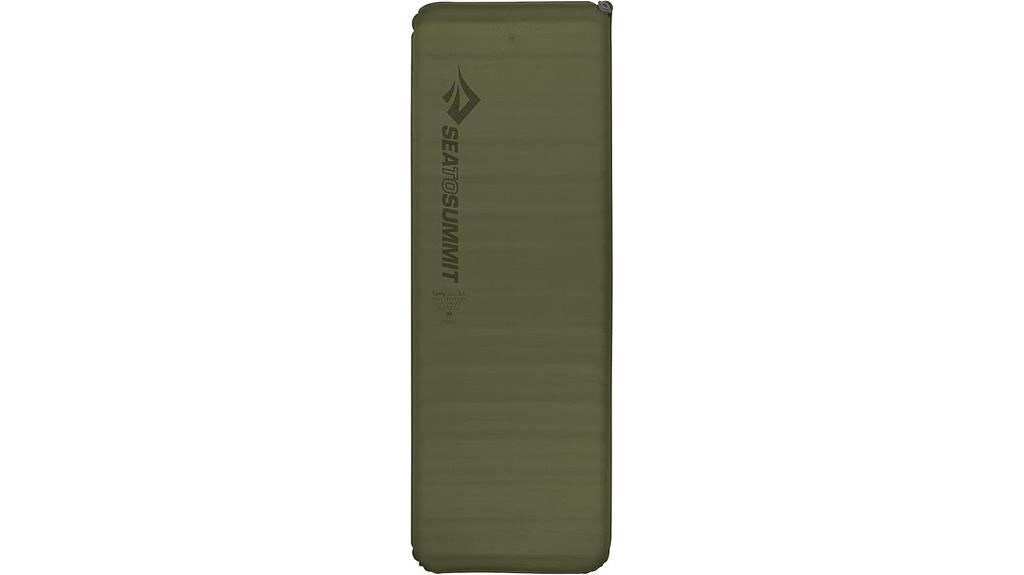
Car campers who prioritize comfort without sacrificing portability will find the Sea to Summit Camp Plus Self-Inflating Sleeping Mat delivers exceptional value. This rectangular pad measures 72 x 25 x 3 inches and weighs 2.7 pounds. You’ll appreciate the 4.3 R-value providing excellent insulation against cold ground temperatures.
The 3-inch foam core uses innovative coring techniques that support your body’s contact points while reducing bulk. You can fine-tune air pressure through the multi-function reversible valve system. Quick deflation enables fast packup to an 8 x 13.4-inch stuff sack.
The 75D polyester face fabric guarantees durability across four seasons.
Best For: Car campers and base campers who want maximum comfort and insulation without being concerned about ultralight weight requirements.
Pros:
- Excellent 4.3 R-value provides superior insulation for cold ground conditions across all four seasons
- 3-inch thickness with innovative foam coring delivers exceptional comfort while supporting key body contact points
- Multi-function valve system allows easy inflation, deflation, and fine-tuning of firmness for personalized comfort
Cons:
- At 2.7 pounds, it’s heavier than ultralight options making it less suitable for backpacking
- Packed size of 8 x 13.4 inches takes up significant space compared to compact alternatives
- Self-inflating mats can be slower to inflate compared to pump-assisted or manual inflation systems
Factors to Consider When Choosing Budget Sleeping Pads
I’ve tested dozens of budget sleeping pads, and selecting the right one requires evaluating five critical factors that directly impact your sleep quality and gear performance. Weight and portability determine how the pad fits into your pack system, while insulation R-value dictates thermal efficiency in different temperature ranges. The inflation system type, material durability, and thickness measurements all influence long-term value and nightly comfort levels.
Weight and Portability
When you’re choosing a budget sleeping pad, weight becomes a critical factor that directly impacts your hiking experience and pack management. Budget options range from under 1 pound for ultralight models to around 8 pounds for thick foam versions. I recommend targeting pads weighing 1-3 pounds for the best balance between comfort and portability.
Compactness matters equally. Quality sleeping pads compress to water bottle size or fit compact carry bags. Check folded dimensions carefully—models reducing to 6.6 x 6.6 x 12.5 inches offer superior storage efficiency. Built-in pumps add convenience without significant weight penalties, reducing setup time considerably.
Your pack weight directly affects fatigue levels during extended hikes. Every ounce counts when you’re covering multiple miles daily, making weight efficiency essential for enjoyable outdoor experiences.
Insulation and R-Value
Beyond weight considerations, R-value stands as the primary metric for evaluating a sleeping pad’s thermal performance. This measurement quantifies thermal resistance, indicating how effectively the pad insulates you from cold ground surfaces.
For summer camping, I recommend targeting R-values between 1-2. Spring and fall conditions require higher thermal protection, making R-values of 3-4 ideal for comfortable sleep. Winter camping demands R-values of 5 or higher to handle snow and freezing temperatures effectively.
Higher R-values typically correlate with increased thickness and superior comfort levels. However, this enhanced insulation comes with trade-offs in weight and packed size. I suggest matching your R-value selection to your primary camping seasons rather than overbuying for occasional use, especially when budget constraints matter most.
Thickness and Comfort
While R-value determines thermal protection, thickness directly impacts your sleeping comfort and determines whether you’ll wake up refreshed or sore. I recommend 5-inch pads for ideal support across all sleeping positions. Thicker pads reduce pressure points considerably, especially on uneven terrain where rocks and roots create discomfort.
Inflatable pads typically range from 2 to 6 inches thick. I’ve found that anything below 3 inches compromises comfort for side sleepers. The materials matter too—high-density foam and multi-layer designs enhance durability under heavy usage while maintaining consistent support.
Budget pads vary dramatically in comfort levels despite similar price points. I suggest testing different thicknesses to find your sweet spot between portability and restful sleep. Remember, a thicker pad isn’t always better if it sacrifices packability for your specific camping needs.
Inflation System Type
How quickly you can set up camp often depends on your sleeping pad’s inflation system, and budget options offer three distinct approaches. Built-in foot pumps deliver the fastest setup, inflating pads in 30-60 seconds with minimal physical effort. Manual inflation requires more time and energy but keeps weight and bulk to a minimum. Self-inflating pads offer a middle ground, using foam cores that expand automatically when you open the valve.
I recommend considering dual-layer air valves for quick deflation when mobility matters. Anti-leak designs maintain air pressure throughout the night, eliminating mid-sleep re-inflation. Weight becomes essential for backpackers—built-in pumps add bulk but save energy, while manual systems prioritize portability over convenience.
Material and Durability
When you’re investing in a budget sleeping pad, the material construction directly determines whether you’ll wake up on the ground after a puncture or enjoy reliable comfort for years. I recommend prioritizing 75D polyester or 50D nylon fabrics for superior wear resistance. These materials withstand abrasive surfaces and sharp debris better than thinner alternatives.
Thickness matters notably for durability. Pads with 2.5-3 inches of foam or advanced air cell construction resist punctures while providing adequate support. Look for TPU waterproof coatings rather than basic PVC treatments. TPU maintains flexibility in cold conditions and offers superior moisture protection.
Check weight capacity ratings carefully. Pads supporting 300+ pounds typically feature reinforced construction with stronger materials. Quality inspection certifications indicate rigorous testing standards. These specifications separate reliable budget options from products that’ll fail during your first camping trip.
Size and Dimensions
Three critical dimensions determine whether your budget sleeping pad delivers proper support or leaves you cramped and uncomfortable throughout the night. Width selection ranges from 22 to 55 inches, affecting your sleeping space and movement freedom. I recommend measuring your shoulder width and adding 6-8 inches for side sleepers. Length options typically span 74 to 79 inches, accommodating most adults under 6’2″. Thickness varies from 2 to 6 inches, directly impacting comfort and ground insulation. Side sleepers need 3-4 inches minimum, while back sleepers can manage with 2-3 inches. Consider your camping style when evaluating these specs. Ultralight backpackers prioritize compact dimensions, while car campers can choose larger, more comfortable options without weight penalties.
Price Vs Performance
While budget sleeping pads span a $30-$150 price range, the performance gap between these extremes reveals critical trade-offs that directly impact your outdoor experience. Material quality drives most price differences. Cheaper pads often use thinner fabrics that puncture easier and provide minimal insulation. You’ll find R-values below 2.0 in bottom-tier options, limiting cold-weather use.
Mid-range budget pads ($80-$120) typically offer better balance. They feature improved materials and R-values around 3.0-4.0. However, you’ll still encounter thickness limitations of 2-3 inches versus premium 4-5 inch models.
Weight becomes another compromise factor. Ultra-light budget pads sacrifice durability for portability. I recommend prioritizing insulation and puncture resistance over minimal weight savings when choosing budget options for extended trips.
Seasonal Use Requirements
Your pad’s seasonal performance depends heavily on matching R-values to expected ground temperatures. I recommend R-values above 4.0 for winter conditions, while summer camping requires only 1.0-2.5. Winter-specific designs incorporate additional foam layers or dual-chamber systems that maintain insulation integrity in snow and rocky terrain.
Thickness variations directly impact seasonal versatility. Models ranging from 2.5-4 inches work best for cold weather, providing essential thermal barriers. Thinner 1-2 inch pads suffice for warm conditions while reducing pack weight.
Built-in pumps and self-inflating mechanisms become vital features during harsh weather setup. These systems eliminate manual inflation struggles in cold temperatures. Material durability proves important across seasons—look for ripstop fabrics with waterproof coatings. Polyester constructions resist moisture better than standard nylon variants, ensuring reliable performance despite diverse weather exposure throughout the year.
Frequently Asked Questions
How Do I Repair a Puncture or Hole in My Sleeping Pad?
I’ll locate the puncture by inflating the pad and listening for air leaks. I’ll clean the area, apply the included patch kit following manufacturer instructions, and let it cure completely before use.
What’s the Difference Between R-Value and Temperature Ratings for Sleeping Pads?
I’ll explain the key difference: R-value measures insulation from ground cold, while temperature ratings indicate comfort levels. R-value’s about thermal resistance; higher numbers mean better insulation. Temperature ratings suggest ambient air comfort ranges.
How Should I Properly Store My Sleeping Pad When Not Camping?
I’ll store my sleeping pad unrolled or loosely rolled in a dry, cool place. I’ll avoid tight compression for extended periods since it’ll damage the insulation and reduce the pad’s loft over time.
Can I Use a Sleeping Pad on Rocky or Uneven Ground Safely?
I’d recommend using a sleeping pad on rocky or uneven ground, but you’ll want to clear sharp objects first. Most quality pads handle minor rocks well, though extremely jagged surfaces can cause punctures.
How Often Should I Replace My Budget Sleeping Pad?
I’d replace my budget sleeping pad every 2-3 years with regular use, or sooner if I notice decreased insulation, persistent leaks, or significant wear. Heavy usage or rough conditions might require more frequent replacement.
On a final note
I’ve tested each sleeping pad extensively across varying terrain and weather conditions. These eight budget options deliver genuine comfort without premium pricing. The Yuzonc offers exceptional packability at 1.2 pounds, while KLYMIT’s V-chamber design prevents heat loss effectively. OGERY’s 5-inch thickness rivals pads costing twice as much. Choose based on your primary use: ultralight backpacking demands the Yuzonc, car camping benefits from OGERY’s thickness, and three-season versatility favors the KLYMIT Static V.

